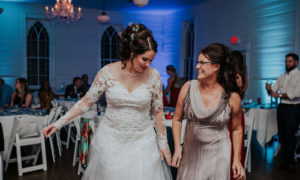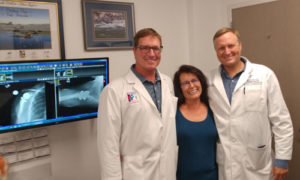
On April 9, 2016, Kathy fell skiing in the heavy spring snow at Steamboat Ski Resort. Within 5 minutes of falling, her entire arm went numb. Ski Patrol confirmed that Kathy had dislocated her shoulder. She was put in a sled and taken down the mountain. In the ambulance, the paramedics reduced her shoulder, which drastically decreased the shoulder pain she was experiencing.
A local to Steamboat Springs, Kathy went to a physician in the area. Due to the numbness in her right arm, she was instructed to get an electromyogram (EMG). An EMG is a test that is used to record the electrical activity of muscles. Her EMG report showed that she had severe nerve deficits in multiple distributions and that she had severe damage to her brachial plexus. She also learned that she had a 5-10% chance of regaining feeling in her right arm. In addition to the nerve damage, she also sustained a proximal humerus fracture, and a rotator cuff tear.
During her initial evaluation, she was informed that her best option was to surgically repair the displaced proximal humerus fracture by stitching the bone back into place while also repairing the rotator cuff. She was informed that the fracture on the humeral head would heal on its own.
Six days after her accident, Kathy had her first surgery. At her eleven-day postoperative visit she was told by the physician to remove the sling. Kathy and her physical therapist were very concerned that she was mobilizing the joint too quickly. She called the surgeon to confirm that he wanted her out of the sling, and he said, “Yes.” Kathy continued with her physical therapy as instructed. One month following surgery, Kathy went back in to discuss her injuries. During her appointment, she got a follow-up x-ray of her shoulder. The x-ray confirmed that the shoulder surgery had failed. “I was in worse shape than before the surgery,” said Kathy. “I asked for advice from friends in the medical field as well as my physical therapist. They all suggested that I get a second opinion. I called The Steadman Clinic and they had an opening with Dr. Hackett.”
The next day, Kathy had her first appointment with Dr. Hackett. After x-rays and an evaluation of the MRI and CT scans, it was confirmed the initial surgery had failed. The bone had not healed and the rotator cuff repair also ultimately failed. The imaging also showed that the fracture had separated and there was a one-inch gap between the bones in the humeral head.
In May of 2016, Kathy had her second surgery. Dr. Hackett plated and pinned the gap closed. He also removed the remaining scar tissue and placed a bone graft in the humeral head to assist with healing. After surgery, the nerve damage started to improve and Kathy began passive motion at physical therapy. Unfortunately, during Kathy’s follow-up appointment in November, it was discovered that her shoulder had locked-up and her passive range of motion was only at 10%.

Not seeing an improvement in her symptoms, Kathy decided to have a third surgery. This surgery was very extensive. Dr. Hackett placed a bone graft from her hip into the shoulder to help promote healing. He also took biopsies from the shoulder to test for any bacteria that could be hindering the healing process. The results from the biopsy confirmed that Kathy had P-Acnes bacteria, and she began oral anti-biotics for six months.
“The surgery itself was very successful,” said Kathy. “I started to see an even greater improvement in my nerve function. At physical therapy, I had a dramatic increase in my passive range of motion and strength. My follow-up x-rays showed that the bone was beginning to grow back. By January I was doing really well!”
“After getting stronger and feeling really good, I started to experience pain and crunching in my shoulder 4 months later,” Kathy said. “An X-ray review confirmed that the bone graft had failed. There was no blood supply to help with healing, and the humeral head was beginning to collapse. At this point, I needed a reverse shoulder replacement due to the extent of the damage in my joint. Dr. Hackett told me he wanted his friend and partner Dr. Provencher to perform the surgery.”
Before meeting with Dr. Provencher, Kathy had another EMG to evaluate the status of her nerve damage. “The results were very good. I had 85-90% of my nerve function back. I thought it was a complete miracle, since I was told from the beginning that I had a 5-10% chance of getting feeling back at all.”
A year after her accident, Kathy met with Dr. Provencher for the first time. “He made me feel very comfortable and he was so easy to talk with. He took the time to answer all of my questions, and I felt like he had a good understanding of my injury and truly cared about me. It was obvious that Dr. Provencher and Dr. Hackett had spoken in detail about my dilemma.”

Before the reverse shoulder replacement, Dr. Provencher performed an exploratory surgery to take samples of the bone, tissue and muscles to be sure there was no sign of infection in the shoulder. In May 2017, Dr. Provencher took nine cultures from her shoulder and removed scar tissue. The results from the biopsies showed that one of the nine tested positive for P-Acnes bacteria.
“I met with Dr. Provencher again and we decided on the right course of treatment together. In June, 2017, he took out the infected hardware and the top of my humeral head, and put in a spacer infused with antibiotics. The day after surgery, the nurse tried to insert a PICC line and found that my veins were too small to perform the procedure safely. I had to go back into surgery the next day to put in a central line for the IV.” Once that process was complete, Kathy took IV antibiotics for six weeks.
Three weeks after finishing the IV antibiotic treatment she had a final surgery to get the spacer removed and receive the full reverse shoulder replacement. During this seventh and final surgery, Dr. Provencher performed the reverse shoulder replacement, removed more scar tissue and took biopsies to confirm that the P-Acnes was gone.
“The results from the surgery were fantastic. I was infection free! I had feeling back in my arm. I was regaining range of motion and strength quickly, and most importantly, I was pain free! I am so thankful to Dr. Provencher for helping me get my life back! There is not much that I am unable to do. I am back to horseback riding, Pilates, swimming and skiing.”

“At my two-month post-operative visit, Dr. Hackett and Dr. Provencher both met with me. I felt like I had my team of heroes around me. It was truly special to see the two of them interact and to see how excited they were about the work they were doing and what they had done for me!”
“I would tell other patients who are going through a unique situation like mine to go to the professional that you need. Find the guy who handles your type of injury all of the time. Don’t be afraid to research online, and find the surgeon with the right credentials. I would highly recommend Dr. Provencher!”
While clinical studies support the effectiveness of these procedures, individual results may vary. There are no guarantees of outcome. All surgeries involve the risk of major complications. Before you decide on surgery, discuss treatment options with your doctor. Understanding the risks of each treatment can help you make the best decision for your individual situation. Always ask your doctor about all treatment options, as well as their risks and benefits. Only your doctor can determine the appropriate treatment for your situation. The clinical information and opinions, including any inaccuracies expressed in this material by patients or doctor are not necessarily those of Matthew Provencher, MD and should not be considered as substitute for medical advice provided by your doctor.